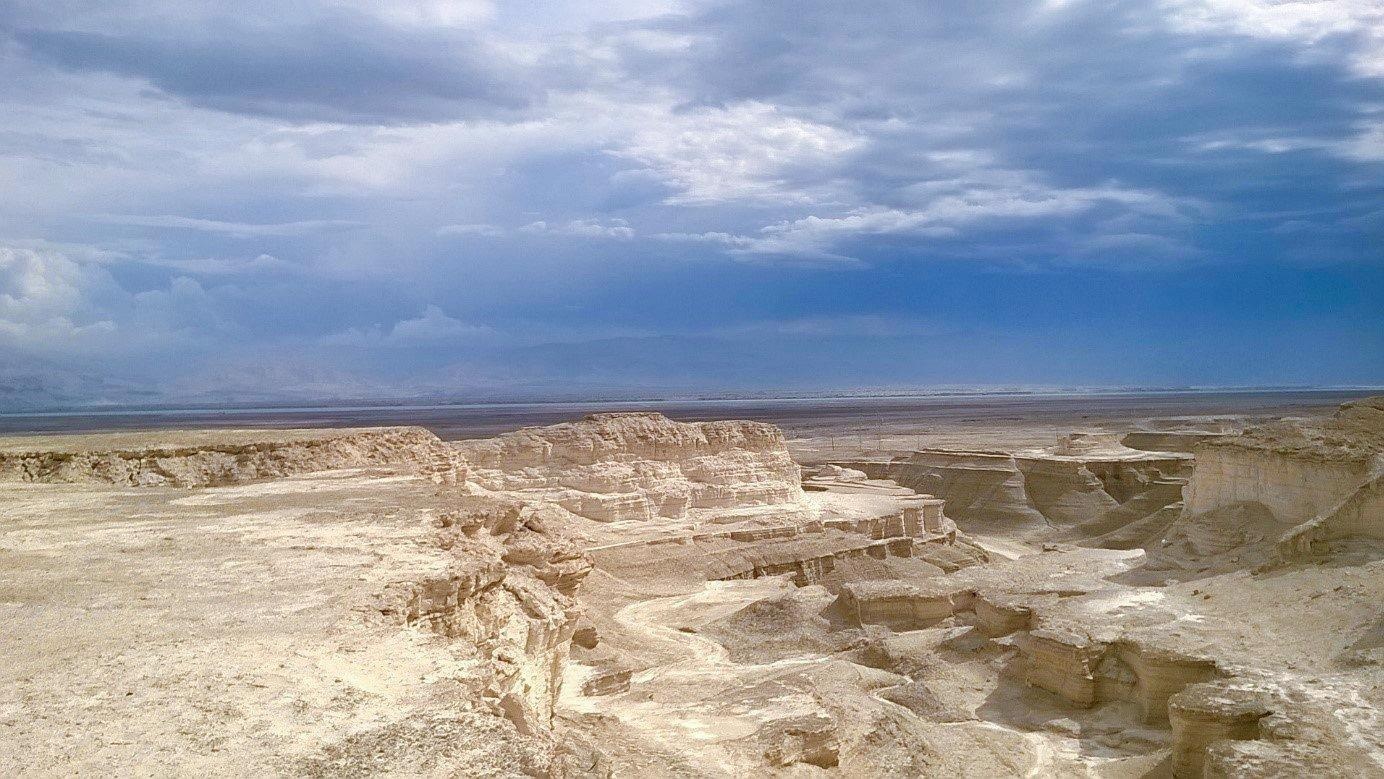At present, the lake level of the Dead Sea is declining by over 1 m annually. This is primarily due to the heavy water usage in the catchment area.
 Sediments formed in the Lisan lake during lake level highstand between ca 24.000 and 14.000 years ago. Today, these lacustrine deposits are found more than 200 m above the water level of the Dead Sea. View from Masada across the Dead Sea. Image Credit: German Research Centre for Geosciences.
Sediments formed in the Lisan lake during lake level highstand between ca 24.000 and 14.000 years ago. Today, these lacustrine deposits are found more than 200 m above the water level of the Dead Sea. View from Masada across the Dead Sea. Image Credit: German Research Centre for Geosciences.
However, very strong lake level drops as a result of climate changes are also recognized from earlier times. For instance, at the end of the last ice age, the water level declined by nearly 250 m within a few millennia.
A study recently reported in the Scientific Reports journal currently offers fresh ideas into the correct course of this process. Daniela Müller and Achim Brauer from the German Research Centre for Geosciences (GFZ) in Potsdam, jointly with collaborators from the Hebrew University of Jerusalem, studied 15,000-year-old sediments obtained from the Dead Sea and the encircling area with the help of newly developed techniques.
With unparalleled precision, the researchers display that the long period of drought was stopped by wet periods lasting around ten to a hundred years. Also, this provides a new understanding of the settlement history of this region, which is essential for human development. Also, it helps in the evaluation of present and future developments caused by climate change.
The Water Cycle at the Dead Sea — Then and Now
In a highly sensitive region like the Eastern Mediterranean, where the availability of water is a significant factor for political and socio-economic development, it is critical to comprehend how the water cycle is altering in response to climate change.
It was possible for geologists to obtain this by evaluating powerful hydroclimatic variations that occurred various millennia back in time. For instance, at the time of the transition from the last ice age to the Holocene, the water level of Lake Lisan declined by around 240 m 24 to 11 thousand years ago. This ultimately results in its shift into the Dead Sea at present.
Sediments as Witnesses of Time
The sediments present at the edge of lake Lisan next to the archaeological site of Masada and from the bottom of what is currently known as the Dead Sea are special witnesses to this development.
In their new study, a team of scientists headed by Achim Brauer, head of Section 4.3 “Climate Dynamics and Landscape Evolution” at the German Research Centre for Geosciences Potsdam, and doctoral student Daniela Müller collectively with collaborators from the Geological Survey Israel and the Hebrew University of Jerusalem, examined these sediments with unparalleled accuracy.
The investigations happened inside the framework of the PALEX project titled, “Paleohydrology and Extreme Floods from the Dead Sea ICDP Core”, which is financially supported by the German Research Foundation (DFG).
New High-Resolution Methods for Sediment Analysis
For the current study, new high-resolution analytical techniques were developed at the GFZ to gain accurate data from the stratification of the sediments and their geochemical composition, as well as seasonal deposition processes and the type, duration, and course of climatic phases.
The combination of light microscopic techniques with alleged 2D element mapping utilizing X-Ray fluorescence scanners is new. This allows for the accurate identification and localization of elements present in the sediments.
Significant and difficult for this is the making of the sediments for this analysis: The moisture should be eliminated from them by freeze-drying, which is not easy provided the high salt content of the Dead Sea and its affinity for water. Furthermore, the sediments are impregnated in synthetic resin and thin sections are created from them. Throughout all of this, the microstructure should not be changed.
Pause in Climate Change: Humid Phases Interrupted Long Dry Periods
The scientists discovered that the considerable long-lasting drop in the lake level as a result of growing dryness was broken various times by wetter phases while climate change took breaks.
In this study, we were able for the first time to precisely determine the duration of these phases with several decades and in one case up to centuries by counting annual layers in the sediment.
Daniela Müller, Study Lead Author, GFZ German Research Centre for Geosciences
The actual cause for such pauses in the climate change of this region is still subtle, however, it is presumed to be linked Fto the North Atlantic climate.
What was particularly surprising was that during these wetter phases, in some cases over several decades, there we even did not find any traces of extreme floods, which are typical for this region even today and during wetter times in the past.
Daniela Müller, Study Lead Author, GFZ German Research Centre for Geosciences
Consequences For Archaeological Considerations and Future Climate Scenarios
Such outcomes are of additional interest for archaeological considerations since they tend to coincide with the time when the Natufian culture happened to settle in this region. Phases that are climatically stable could have preferred the cultural developments.
The study shows that strong climatic changes in the past have been very dynamic and included phases of relative stability. We learn from this that climate change is not linear, but that phases of strong changes alternate with calm phases.
Achim Brauer. GFZ German Research Centre for Geosciences
Journal Reference:
Müller, D., et al. (2022) Phases of stability during major hydroclimate change ending the Last Glacial in the Levant. Scientific Reports. doi.org/10.1038/s41598-022-10217-9.